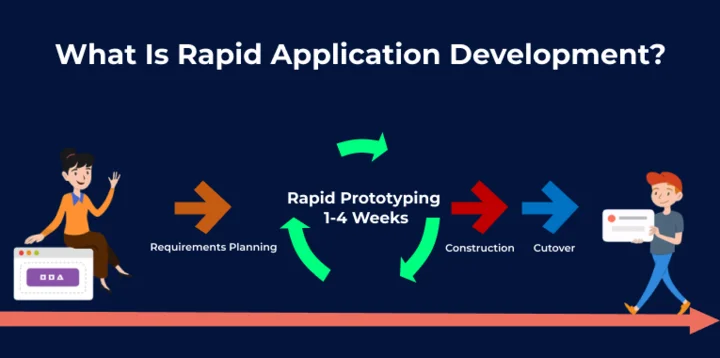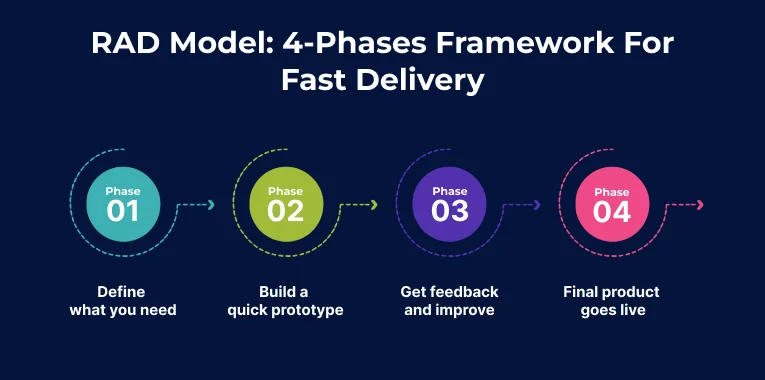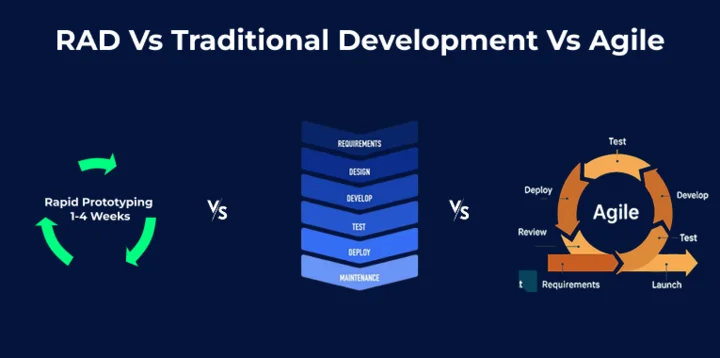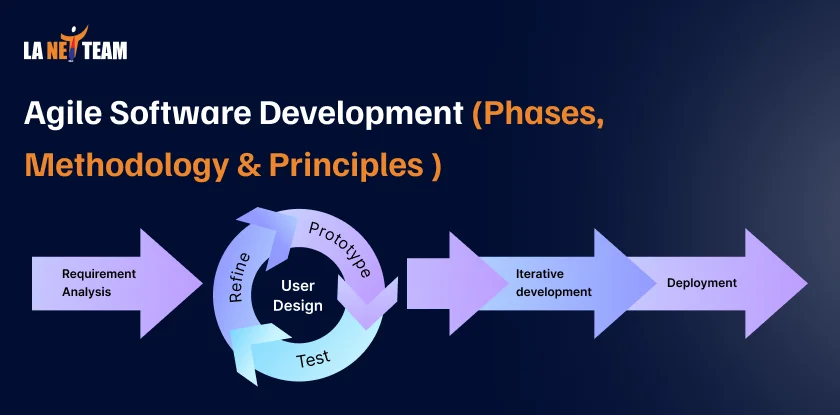When businesses need software, they can’t afford to wait for months or years for a finished product. Markets change quickly, customer demands shift, and opportunities can be lost if development is too slow.
This is where the Rapid Application Development (RAD) model comes in.
Rapid Application Development focuses on speed and flexibility. Instead of spending months planning every detail, RAD builds quick prototypes, shows them to users, and makes changes fast.
The goal is simple: build applications faster without losing quality.
What is Rapid Application Development?

RAD is a method for building software very quickly. Instead of wasting months and resources on building the final product, the team builds a rough model of the product using RAD and shows it to users.
Then users give feedback, & the team improves it. This cycle repeats until the final product is ready. While many traditional methods take years before users see anything, RAD makes sure users get to see, touch, and use early versions of the software in weeks.
The main idea is: build → show → improve → repeat.
Perfect for: Projects where requirements aren’t clear from the start and may often change.
Read more: Learn how the Agile software development methodology handles changing requirements effectively.
The RAD Model: 4-phases framework for fast delivery

Phase 1: Define what you need
The first phase involves figuring out the needs of the project without getting stuck in endless planning. And that could be possible by getting everyone on the same page.
By “everyone,” we mean people involved in the project, including developers, clients, and users, who come together to decide the project’s needs.
The best part? The project needs can be improvised later as the first version is tested, which makes RAD more flexible and adaptable.
Phase 2: Build a quick prototype
Next, the team creates a rough version/prototype of the product. By using easy tools like Figma or Sketch for interactive mockups.
The rough version does not need to be perfect, it should just show how things might look or work. This helps you to analyze whether you are going in the right direction or not. This stage is aligns with Lean Software Development principles, that deliver small, test fast and eliminate waste.
Phase 3: Get feedback and improve
After you have created the rough version, the users and the clients test the prototype and share what they like or don’t.
The team then improvises it as per the given feedback, builds again, and repeats. This back and forth continues until everyone feels the product is on the right track.
This approach works like Extreme Programming (XP). It focuses on short cycles, real user feedback, and constant improvement.
Phase 4: Final product goes live
Once the prototype is refined and everyone’s happy, it’s time to build the final working software.
By fixing bugs, testing everything, and getting it ready for launch. Additionally, you can prepare users to use your software by offering training, and then launch the product.
When to Use the RAD Model?
Every model will not work for every situation; therefore, we must know where RAD works best. Here are:
Situation 1: Simple technology:
RAD works best when the technology used is simple. Whereas, if the system is very advanced and complicated, RAD might not be the right fit.
Situation 2: Prototype focus:
It works great when building and improving prototypes (rough models) is the focus of the project.
Situation 3: Tight deadlines:
One of the core characteristics of RAD is ‘fast work’. Hence, if the project needs to be finished fast or has a tight deadline. RAD is perfect for making your work get delivered on time.
Situation 4: Creative projects:
Best for the projects where you need a lot of new ideas or experimentation. RAD helps by making the changes quickly.
Situation 5: Small to medium projects:
Works well when your team is small or medium-sized, so things stay manageable.
How to use Rapid Application Development Model (RAD) for 100% ROI?
Any model is not useful unless you know the right place to use it. So, when should you choose the rapid application model?
- One of the most important things to remember is to never try to build everything at once. Start with a small working model instead of creating a big product. This makes it easier to test ideas, get feedback, and fix problems early.
- Remember that you don’t have to build everything from scratch. You can reuse the existing modules and tools whenever possible to save time and cost.
- Use modern tools for prototyping, testing, and integration. This speeds up the cycle and reduces manual errors.
- Don’t wait for the test to end. Keep testing prototypes at every stage to ensure quality and avoid last-minute issues.
RAD vs. Traditional Development vs. Agile: Comprehensive Comparison

Every development model that is built does not work the same. Whether it is RAD, Agile, or a traditional model, each has a very different path. And knowing about them individually and which one fits you best is essential. Read below to know their actual difference:
| Aspect | RAD | Traditional Waterfall | Agile/Scrum |
|---|---|---|---|
| What it is | RAD focuses on building quick prototypes and constant user feedback. | Follows a strict sequence of phases (plan, build, test) with little change allowed after starting. | Breaks tasks into short cycles called sprints. This allows for constant feedback, team collaboration, and flexibility. |
| Timeline | 60-90 days fixed | 6-18 months | 2-4 weeks sprints, flexible end |
| User Involvement | Continuous, intensive | Beginning and end only | Regular sprint reviews |
| Documentation | Minimal, just enough | Extensive upfront | Light, iterative |
| Team Size | 3-5 people | 10-20+ people | 5-9 people |
| Change Handling | Expected and embraced | Difficult and costly | Managed through the backlog |
| Risk Profile | Low (fail fast) | High (all or nothing) | Medium (incremental) |
| Best For | Innovation, unclear requirements | Stable, well-defined projects | Most software projects |
| Cost Structure | Lower overall, front-loaded value | High overall, back-loaded value | Medium, steady value delivery |
| Success Rate | 80% for appropriate projects | 29% (Standish Group) | 42% (Standish Group) |
Read more: Understand how the Agile software development framework compares to other models.
Wrapping up
By now, you know RAD is important. Because of its moving fast, testing real, and improving as you go characteristics.
The best part?
By using RAD, you can save time, keep users happy, and get to market while others are planning.
The companies that are not yet using it are’nt losing a lot of their time and money. So the real question is: are you ready to speed up your growth or let your competitors grow?
